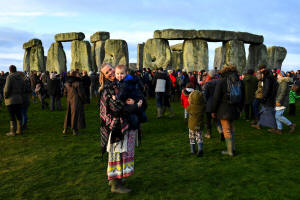Geological analysis explains durability of Stonehenge megaliths
 Send a link to a friend
Send a link to a friend
 [August 05, 2021]
By Will Dunham [August 05, 2021]
By Will Dunham
(Reuters) - The first comprehensive
scientific analysis of Stonehenge's imposing megaliths has revealed some
of the traits that made them an exemplary building material for the
famed monument in southern England including their stout resistance to
weathering.
Researchers on Wednesday described a battery of examinations that
provided a glimpse inside one of Stonehenge's 52 sandstone megaliths,
known as sarsens, gaining insight into its geology and chemistry.
They studied a core sample extracted from one of the sarsens, called
Stone 58, during 1950s conservation work. It was kept in the United
States for decades before being returned to Britain for research in
2018.
The sarsens are made of stone called silcrete that formed gradually
within a few yards (meters) of the ground surface as a result of
groundwater washing through buried sediment.
The examination clarified Stone 58's internal structure. It showed that
the silcrete is comprised of mainly sand-sized quartz grains cemented
tightly together by an interlocking mosaic of quartz crystals. Quartz is
extremely durable and does not easily crumble or erode even when exposed
to eons of wind and weather.

"This explains the stone's resistance to weathering and why it made an
ideal material for monument-building," said University of Brighton
geomorphologist David Nash, who led the study published in the journal
PLoS ONE.
In a remarkable engineering achievement by late Neolithic people, the
sarsens were erected at the site in Wiltshire, England around 2500 BC.
Stone 58, one of the giant upright sarsens at Stonehenge's center,
stands about 7 meters (23 feet) tall, with another 2 meters (7 feet)
underground, and an estimated above-ground weight of 24 tons.
The core sample is a rod of stone, about an inch (2.5 cm) in diameter
and roughly a yard (meter) long. Its cream color is brighter than the
pale-gray exterior of the megaliths, which have been exposed to the
elements for millennia.
It was given as a souvenir to a man named Robert Phillips who worked for
a company involved in the conservation work and was on-site during
drilling. Phillips took it with him with permission when he emigrated to
the United States in 1977. Phillips decided to return it to Britain for
research in 2018. He died in 2020.
[to top of second column]
|

Ann Owen poses with her 11-month-old son Forrest, as they welcome
the winter solstice at Stonehenge stone circle in Amesbury, Britain,
December 22, 2019. REUTERS/Dylan Martinez/File Photo

"Getting access to the core drilled from Stone 58 was
very much the Holy Grail for our research," Nash said. "All the
previous work on sarsens at Stonehenge involved samples either
excavated from the site or knocked off from random stones."
The researchers used CT-scanning, X-rays, microscopic analyses and
various geochemical techniques to study fragments and wafer-thin
slices of the core sample - such testing being off limits for
megaliths at the site.
"This small sample is now probably the most analyzed piece of stone
other than moon rock," Nash said.
It remains unclear precisely when the rock formed, though the
researchers found that some embedded sand grains dated to as long
ago as the Mesoproterozoic Era, 1 billion to 1.6 billion years ago.
Nash led research published last year https://www.reuters.com/article/us-science-stonehenge/scientists-solve-mystery-of-the-origin-of-stonehenge-megaliths-idUSKCN24U2VG
involving the same core sample that showed that 50 of the 52 sarsens
share a common origin about 15 miles (25 km) from Stonehenge at a
site called West Woods. Stonehenge's builders may have either
dragged or moved the huge stones on rollers.
"I think Stonehenge has fascinated archaeologists and other
scientists for centuries now, partly because we don't know what it
was used for exactly, and there are a number of theories as to why
the site was built," Nash said. "It's a site that is still rich with
possibilities for doing more research."

(Reporting by Will Dunham in Washington; Editing by Cynthia
Osterman)
[© 2021 Thomson Reuters. All rights
reserved.] Copyright 2021 Reuters. All rights reserved. This material may not be published,
broadcast, rewritten or redistributed.
Thompson Reuters is solely responsible for this content. |